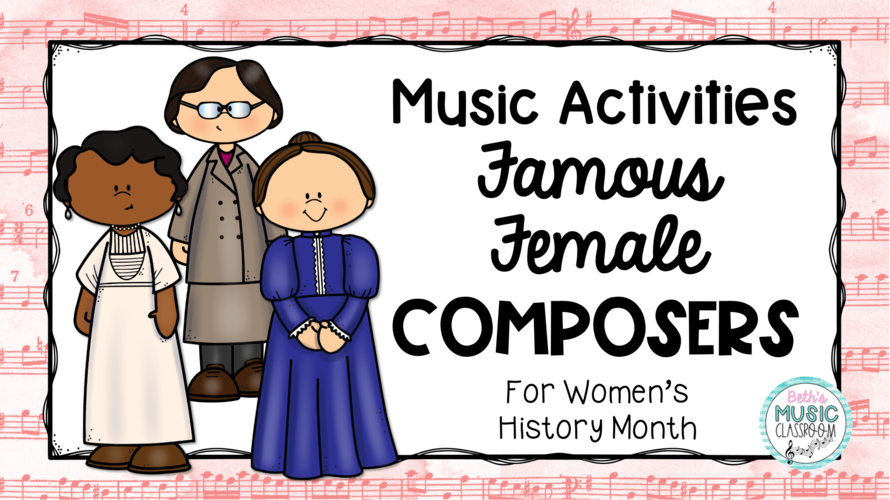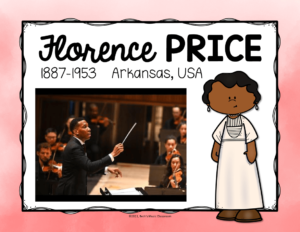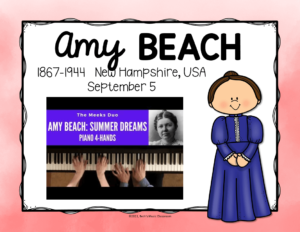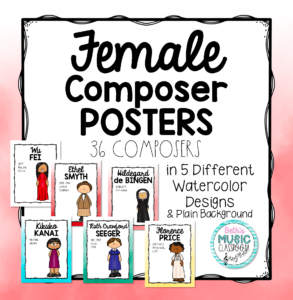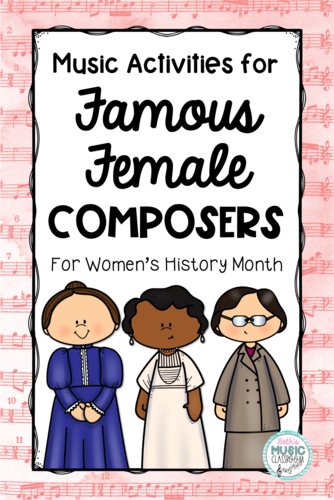3 Famous Female Composers and Music Activities
March is Women’s History Month, and it’s a great time to add some famous female composers to your lessons. Celebrating women composers does not have to be difficult or require lots of prep work. Today, I have several simple music activities on the music of 3 famous female composers.
Florence Price
The first female composer we’ll look at is Florence Price. She was born in 1887 in Little Rock, Arkansas. She is famous for composing over 300 pieces. One of her familiar works is “Juba Dance” from the 3rd movement of Symphony No. 1. “Juba Dance” was first performed by the Chicago Symphony in 1933. This “pattin’ juba” is similar to a hambone style dance of clapping and body percussion.
This wonderful piece includes lots of syncopation and a great opportunity for rhythmic practice. Also, if you’re interested in teaching the “juba” pattern to your students – with all of the hambone motions – click here for some great information from the St. Louis Symphony Orchestra.
Looking to learn more about who Florence Price is? Then check out these two videos and this great music project completed by kids! You can find this amazing work by clicking here (affiliate link – you pay the same price).
Click here for a great video by Rhythm Recess for young students learning steady beat with the music of Florence Price.
Amy Beach
Another great female composer to study during Women’s History Month is Amy Beach. She was born in 1867 in New Hampshire and first learned music from her talented mother. Her “Gaelic Symphony” made her famous as the first successful symphony by an American female composer. Amy Beach also wrote over 150 other works, including choral works and church music.
“Gaelic Symphony” is a lovely, but lengthy piece. Maybe use just the first 3 minutes or so as a dynamic listening activity. I think just about every volume is heard in this part.
Also by Amy Beach, “Summer Dreams, op. 47” is a lovely, flowing piano duet that is perfect to use with a scarf activity. It would be a perfect addition to a lesson on melodic contour as well. You can pull out small phrases from it and play them on the piano for students to aurally decipher the direction of the music. Then add scarves to create an improv or mirror activity for your students.
Nadia Boulanger
Finally, let’s look at Nadia Boulanger, a French composer and pianist. Born in Paris in 1887, she was one of the most influential composition teachers of the 20th century. Her younger sister, Lili Boulanger, was also a great female composer.
Nadia Boulanger taught music at both the Paris and American Conservatory, as well as other universities in the United States. She worked with Aaron Copland, who was her first student in the US, and became the first woman conductor of many major orchestras, including Boston, New York, Philadelphia, and more.
Her music includes a variety of wonderful selections and is great to use in the classroom. Have students listen to 2 or 3 pieces and compare/contrast them. For example, “Cantique,” is a lovely short work for voice and piano. In contrast, her “3 Pieces for Cello and Piano” (“Trois Pièces pour violoncelle et piano”) is longer with 3 unique and interesting sections.
First, the “modere” begins peacefully with a flowing, piano pattern and simple melody in the cello. Next, she moves into the shortest piece of the three, and it is to be “without speed, at ease.” A lot of stepping up and down is heard in the cello melody. At last, the third section is literally “nervously paced” and with high energy as the cello opens with a marked pizzicato. A pattern is passed back and forth from the piano to the cello. Then it seems to twist and turn before a final, lovely ending.
Even with younger students,you could add a little comparison activity for a women’s history music activity. Play (or show a video performance) of a clip of each piece, and create a list of words that describe each piece.
If you’re looking to add some more of Nadia Boulanger’s music activities into your classroom, click here for a kid-friendly site and biography.
Conclusion
In conclusion, I hope that you are able to take away some ideas for your own women’s history music lessons. And don’t forget – there are a lot more famous female composers than just the three in this post. Check out this poster set that includes 36 different women composers from all over the world.
Hey, I’d love to connect with you! Find me on Instagram, on Facebook, or email (beth@bethsmusicclassroom.com).
If you’re looking for some composer organization tips, click here to check out this helpful post plus get a freebie!

